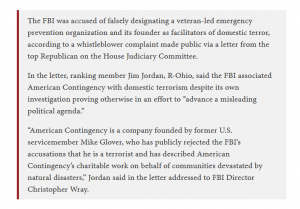FBI labeled veterans group “terror organization” despite knowing they weren’t
BY PGFIt seems increasingly likely that there is a core group of agents inside of the FBI that have grown tired of the overt politicization of the Bureau under the leadership of Christopher Wray and the direction of the Biden administration. Another whistleblower has reportedly come forward and presented information to members of Congress about the abuses taking place inside the FBI. Congressman Jim Jordan of Ohio (R) received a complaint from someone inside the agency over the FBI’s designation of American Contingency, a veteran-led group that assists people in the wake of natural disasters, as being “facilitators of domestic terror.” And it was further revealed that the FBI already knew this wasn’t true, having previously investigated the group and found them to be on the up and up. (Yahoo News)

[…]
So the FBI knew all of this, and yet they kept the “domestic terrorism” tag attached to his group [Mike Glover and American Contingency] anyway. You should be starting to detect a pattern here. Joe Biden has repeatedly stated that “white supremacists” or “MAGA Republicans” and “domestic terrorists” are the greatest threat the country faces. The problem is, the supply of actual conservative domestic terrorists massively lags behind the demand for them inside the White House. So Christopher Wray appears to be doing his level best to invent some just to make Biden’s claims look less far-fetched.
There’s more at the source.



